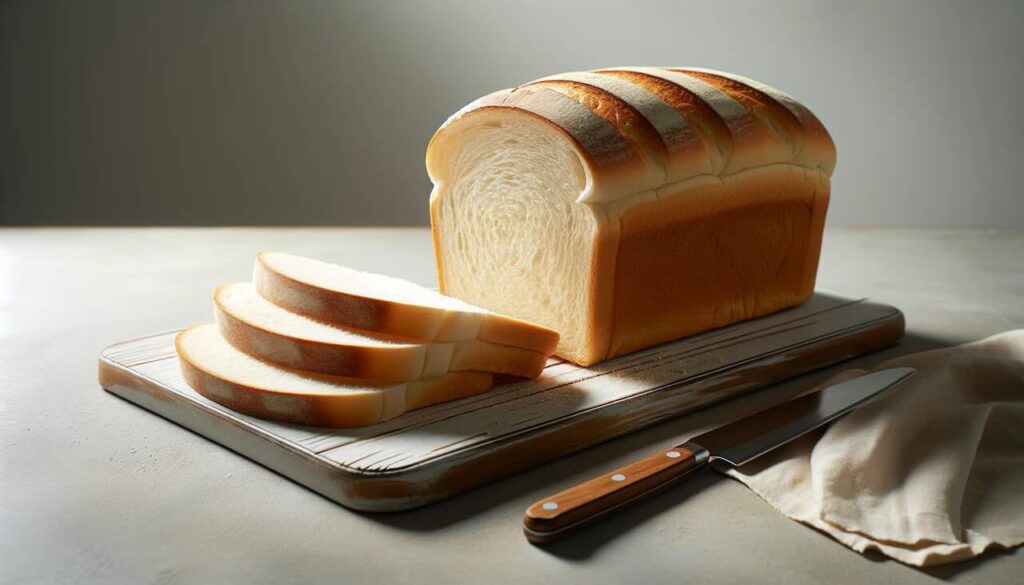If you’ve ever wandered through a Japanese supermarket or convenience store, you’ve likely encountered the unmistakably soft, pillowy loaves of shokupan (食パン) — Japan’s signature white bread. But have you ever stopped to wonder: why is it called shokupan rather than simply “pan,” like most other breads in Japan?
Beneath this simple name lies a surprisingly rich history that reflects Japan’s evolving relationship with bread — from foreign curiosity to everyday staple.
- The Arrival of Bread in Japan: A Foreign Import
- The Birth of Shokupan: Bread Becomes a Staple
- Shokupan’s Role in Post-War Japan
- How Shokupan Differs from “White Bread” in the West
- The Language of Japanese Bread: Why “Shokupan” Stuck
- My Personal Connection: The Comfort of Shokupan
- The Nutritional Side of Shokupan
- Summary: Shokupan as a Reflection of Japan’s Bread Journey
The Arrival of Bread in Japan: A Foreign Import
Bread first arrived on Japanese shores in the 16th century, brought by Portuguese missionaries and traders. In fact, the Japanese word for bread, “pan” (パン), is a direct borrowing from the Portuguese word pão.
- For centuries, bread remained something of an exotic novelty in Japan.
- It was largely confined to port cities and foreign settlements.
- Most Japanese people continued to rely on rice as their primary staple.
It wasn’t until the Meiji era (1868–1912), as Japan opened up to Western influence, that bread began to slowly enter Japanese culinary consciousness.
The Birth of Shokupan: Bread Becomes a Staple
The term shokupan (食パン) began to emerge in the early Taisho period (1912–1926), as Japan modernized and Western-style bakeries spread.
But why add “shoku (食)” to “pan”?
- The word “shoku” (食) means “meal” or “food” in Japanese.
- Early on, most bread consumed in Japan was viewed as a snack or dessert — think sweet buns (kashi-pan) or curry-filled rolls (kare-pan).
- Adding shoku distinguished this particular kind of bread as something designed to be eaten as a main part of a meal, similar to how rice functions as the centerpiece of traditional Japanese dining.
- Shokupan was light, fluffy, and neutral in flavor, making it highly adaptable for breakfast, sandwiches, and toasts.
In short, shokupan was Japan’s way of saying: “This is bread meant for everyday eating.”
Shokupan’s Role in Post-War Japan
After World War II, Japan faced severe food shortages. The government, aided by American food aid, promoted wheat-based products to supplement the struggling rice supply:
- Bread became a major feature of school lunch programs.
- Shokupan emerged as a nutritious, easy-to-produce option to feed a population recovering from wartime devastation.
- Its convenience, affordability, and soft texture helped it win over generations of Japanese households.
While rice eventually regained its central place at the Japanese table, shokupan remained firmly rooted as a breakfast favorite, loved for its softness, mild sweetness, and versatility.
How Shokupan Differs from “White Bread” in the West
Though often compared to American or European white bread, shokupan has distinct characteristics:
- Softer and fluffier: Thanks to careful kneading, longer fermentation, and sometimes milk or cream in the dough.
- Slightly sweet: Many recipes add sugar or honey for a delicate sweetness.
- Perfectly square shape: Traditionally baked in lidded pullman-style pans.
- Smooth crumb and fine texture: Resulting in a melt-in-the-mouth softness.
In Japan, this texture isn’t just a preference — it’s practically an art form, with high-end shokupan bakeries elevating simple loaves to gourmet levels.
The Language of Japanese Bread: Why “Shokupan” Stuck
Unlike many Western countries where white bread is simply called “bread,” Japan uses shokupan to clearly categorize this specific kind of bread:
- Pan (パン) = bread in general
- Shokupan (食パン) = sliced, unsweetened, soft white sandwich bread
- Kashi-pan (菓子パン) = sweet breads and pastries
- Chori-pan (調理パン) = prepared savory breads (e.g., curry buns, sandwiches)
This functional classification system reflects Japan’s culinary precision and attention to detail even in language.
My Personal Connection: The Comfort of Shokupan
For many Japanese families, shokupan isn’t just bread — it’s woven into daily life:
- Morning toast with butter and jam.
- French toast made with thick, fluffy slices.
- Egg salad sandwiches (tamago sando), where the soft bread cradles creamy fillings.
Personally, my fondest memories are of my mother’s simple butter toast, made with freshly sliced shokupan on weekend mornings. Even today, one bite of that lightly toasted, buttery slice brings back the warmth of childhood.
The Nutritional Side of Shokupan
Though indulgent in texture, shokupan can also be part of a balanced diet:
- Good source of carbohydrates and fiber.
- Fortified varieties may include added vitamins and minerals.
- Naturally low in fat (depending on toppings and fillings, of course).
As with all things, moderation is key — especially with generous spreads of butter or sweet toppings!
Summary: Shokupan as a Reflection of Japan’s Bread Journey
The “shoku” in shokupan tells the story of how Japan adapted a foreign food into its own cultural fabric. What started as an imported curiosity became a staple of Japanese daily life, shaped by history, language, and uniquely Japanese preferences for softness, simplicity, and versatility.
Next time you bite into a slice of shokupan, you’re tasting more than just bread — you’re savoring a little piece of Japan’s modern culinary history.


